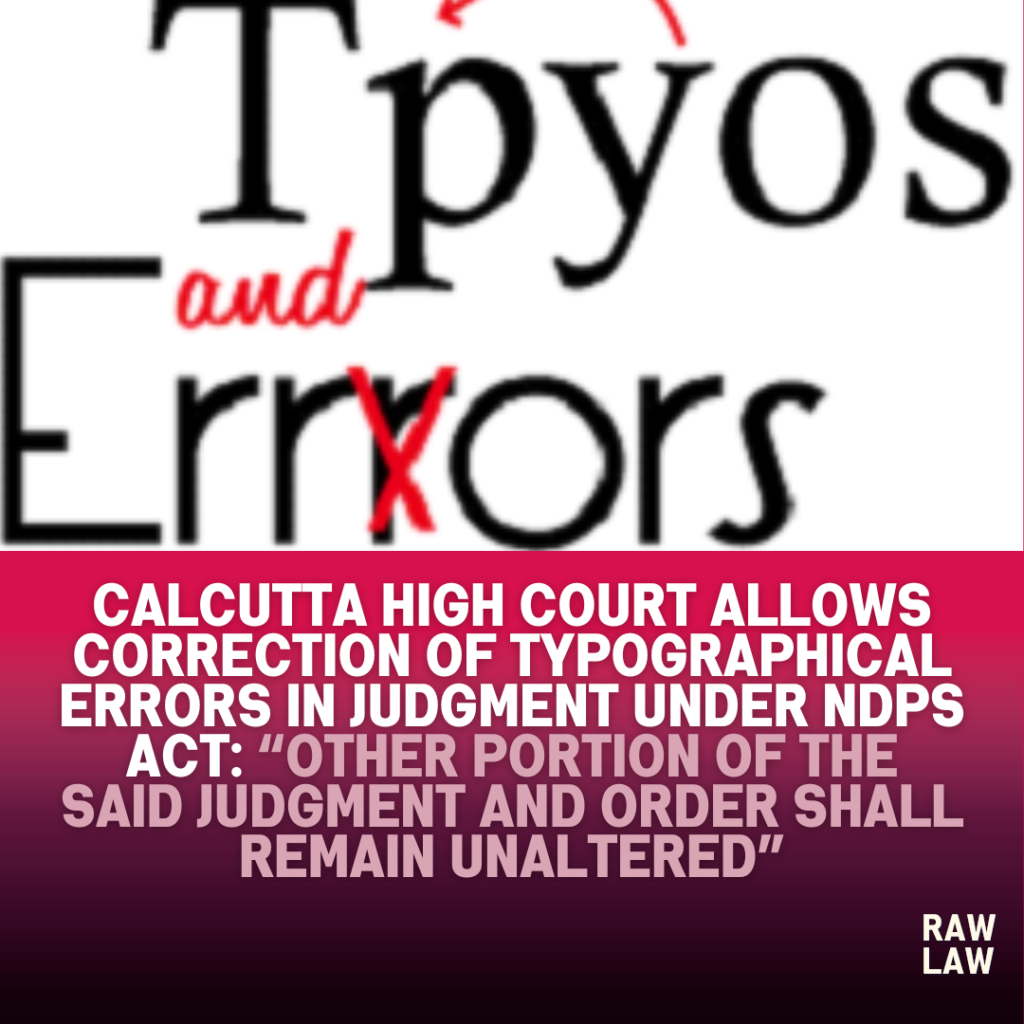Court’s Decision
The Calcutta High Court allowed a correction petition in a judgment passed under the Narcotic Drugs and Psychotropic Substances Act, 1985, permitting typographical corrections in the names of advocates appearing for the parties. The Court ordered that the advocate’s name for the petitioner be corrected from “Mr. Sourab Mondal” to “Mr. Sourov Mondal”, and further directed that the name of the learned Public Prosecutor Mr. Debasish Roy be inserted before the name of the Additional Public Prosecutor Mr. Rudradipta Nandy. Importantly, the Court clarified that “other portion of the said judgment and order shall remain unaltered.”
Facts
In this matter, the petitioner had earlier approached the Court under the NDPS Act. After the final judgment and order was delivered on 8 July 2025, it was noted that certain typographical errors had occurred in recording the names of the advocates. Specifically, the petitioner’s advocate was mistakenly recorded as “Mr. Sourab Mondal” instead of “Mr. Sourov Mondal”, and the name of the learned Public Prosecutor Mr. Debasish Roy was inadvertently omitted.
Issues
Whether the Calcutta High Court can correct typographical errors relating to the names of advocates in a previously delivered judgment, and whether such corrections affect the substantive portion of the judgment.
Petitioner’s Arguments
The petitioner submitted that the judgment dated 8 July 2025 contained typographical mistakes. The counsel’s name had been wrongly mentioned as “Mr. Sourab Mondal” and the name of the learned Public Prosecutor was omitted. It was prayed that these errors be rectified to ensure the correct record of appearance.
Respondent’s Arguments
The State did not object to the correction and submitted that there was no opposition to incorporating these changes since they were clerical in nature and did not affect the substance of the order.
Analysis of the Law
The Court exercised its inherent power to rectify clerical or typographical errors that do not affect the reasoning or outcome of the judgment. Under Section 362 of the Code of Criminal Procedure, the Court cannot alter or review its judgment except to correct a clerical or arithmetical error. This power is preserved for ensuring that official records reflect correct procedural details without modifying the merits of the decision.
Precedent Analysis
Although no specific case law was cited in the present correction order, it is well established through precedent that courts can correct typographical and clerical errors as long as such corrections do not alter the reasoning or the operative part of the judgment. This procedural power has been upheld in various decisions by the Supreme Court and High Courts to preserve the integrity of judicial records.
Court’s Reasoning
The Court noted that the errors were purely typographical. The correction of the petitioner’s counsel’s name and inclusion of the State counsel’s name were necessary to accurately reflect who appeared during the hearing. The Court held:
“Let the correction be incorporated and be made part of the judgment and order dated 8th July, 2025 and other portion of the said judgment and order shall remain unaltered.”
This made it clear that the substantive portion of the judgment was untouched and that the correction was only ministerial in nature.
Conclusion
The Calcutta High Court allowed the correction of typographical errors in the judgment dated 8 July 2025 to accurately reflect the appearance of counsels, emphasizing that the substantive part of the judgment remained unaffected. The corrected judgment now forms part of the official record, and any certified copies issued will reflect the corrected details.
Implications
- This decision reiterates that courts retain the power to correct typographical and clerical mistakes post-judgment, provided it does not impact the merits of the case.
- It underlines the importance of accurate court records, particularly in sensitive matters under statutes like the NDPS Act.
- It serves as a procedural precedent for parties seeking correction of such mistakes in future without reopening the merits of the matter.
Referred Cases and Their Relevance
No specific judgments were cited in the correction order. However, the Court exercised established legal principles concerning the rectification of clerical errors under its inherent powers.
FAQs
- Can a court correct typographical errors in a final judgment?
Yes, courts can correct clerical or typographical errors without altering the substance of the judgment under their inherent powers or under Section 362 CrPC. - Did this correction impact the outcome of the NDPS case?
No, the correction was purely in the names of counsels and did not affect the outcome or merits of the case. - Why is accurate recording of counsel names important in judgments? Accurate records maintain judicial integrity, clarify representation, and avoid procedural confusion in future hearings or appeals.



